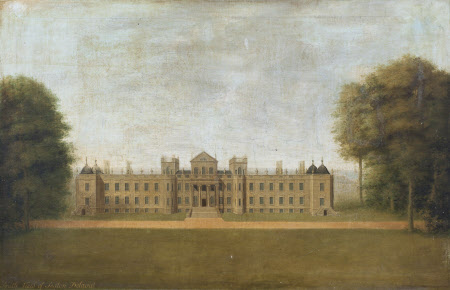View of the South (Park) Front of Seaton Delaval Hall
William Bell (c.1735 - 1794)
Category
Art / Oil paintings
Date
1774 - 1775 (exh at RA)
Materials
Oil on canvas
Measurements
876 x 1359 mm (34 ½ x 53 ½ in)
Place of origin
Seaton Delaval
Order this imageCollection
Seaton Delaval Hall, Northumberland
NT 1276816
Caption
This picture, along with a view of the North (entrance) front of Seaton Delaval, was exhibited at the Royal Academy in 1775. It shows the house completed as to the later plan with the wing either side of the main block built up. For most of his life, William Bell was a provincial painter in Newcastle-upon-Tyne. His masterpieces are the series of portraits in the gallery at Seaton Delaval.
Summary
Oil painting on canvas, View of the South (Park) Front of Seaton Delaval Hall, by William Bell (1735 - Newcastle-upon-Tyne ?1806). One of a pair of views of Seaton Delaval Hall, the other of the North front (NT 1276814). Preparatory studies for both views are in the collection of the Duke of Northumberland.
Full description
The pictures show the house completed as to the later plan (in around 1771 an extra storey was added to the South wings) with the wing either side of the main block built up. R.A. 1775, nos. 24 & 25: “At Sir John Delaval’s. 24: North View of Seaton Delaval, built by Sir John Vanbrugh, the seat of Sir J.H. Delaval, Bart. 25: A South View of ditto” See the two views in a private collection, purportedly by James Miller. They are, however, exact copies after [? check which are the prime versions] the Bells, even down to the arrangement of trees. The only difference is the script, which is here in capitals, rather than italicized. William Bell is little known for two reasons: that he was for most of his life a provincial painter, in Newcastle-upon-Tyne; and that for half a decade or more, from c.1770 to at least 1775 he was “limner” – the term was as old-fashioned as the mode of employment – to Sir John Hussey Delaval (cr. Baron Delaval of Redford in the Irish Peerage in 1783, and Seaton Delaval in the British Peerage in 1786. Yet these portraits show him to have been a gifted and individual painter, and his London career was much more promising. He was – at the advanced age of 34 – the first student to enter the newly-founded Royal Academy’s Schools in 1769, and won a gold medal there for a painting of Venus Entreating Vulcan to forge Arms for Aeneas in 1771. It seems likely that he was related to Alexander Bell, who carved stonework at Seaton Delaval between 1764 and 1768, and who returned there in 1776 to build the mausoleum. That may have been the connection that brought William to Seaton Delaval, where he not only painted the four original whole-lengths, but also extended earlier family portraits to make a set with them. They all hang in the Gallery, along with the Astley / Hasting chairs and settees upholstered with the Tournament embroidery. Other portraits by Bell are in what is now the main repository of Delaval pictures, Dodington Hall, Lincolnshire. After this activity for Lord Delaval, Bell retired back to Newcastle, and sank into provincial obscurity. He seems, towards the end of his life, to have became the friend of Thomas Bewick, the wood-engraver of Cherryburn (NT).
Provenance
Accepted in lieu of tax by HM Treasury and transferred to the National Trust in 2009
Credit line
Seaton Delaval, The Hastings Collection (National Trust)
Marks and inscriptions
Bottom left: South View of Seaton Delaval
Makers and roles
William Bell (c.1735 - 1794), artist
